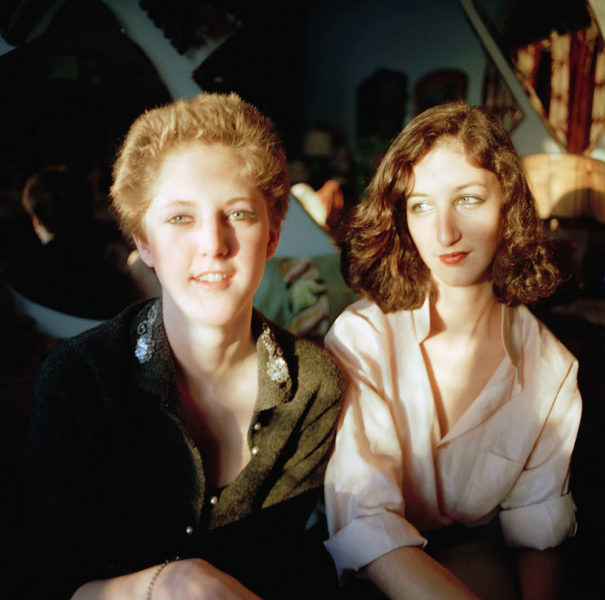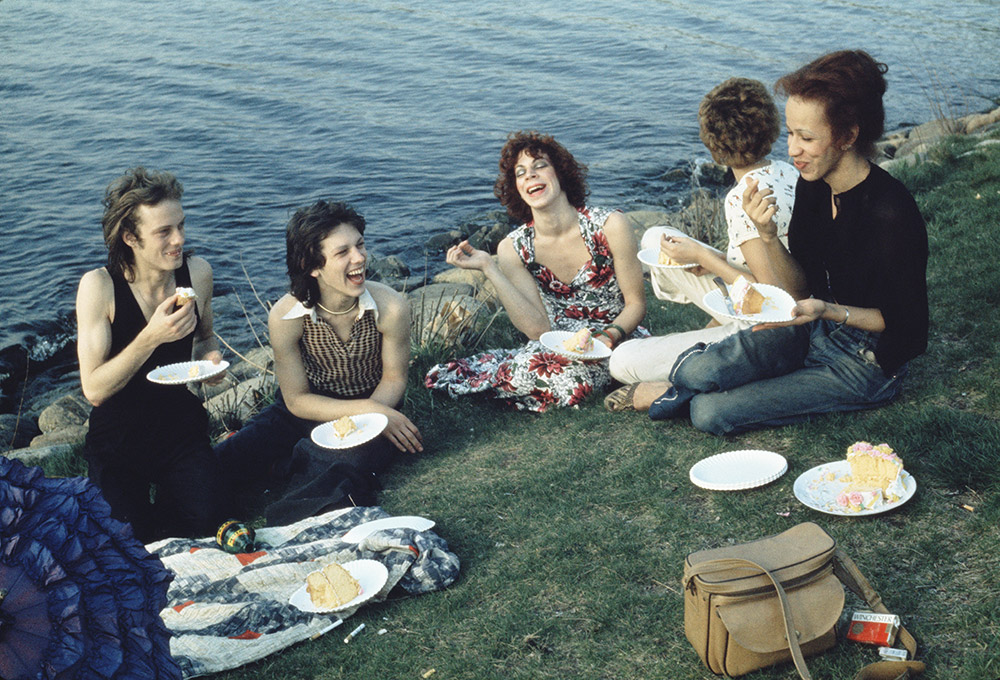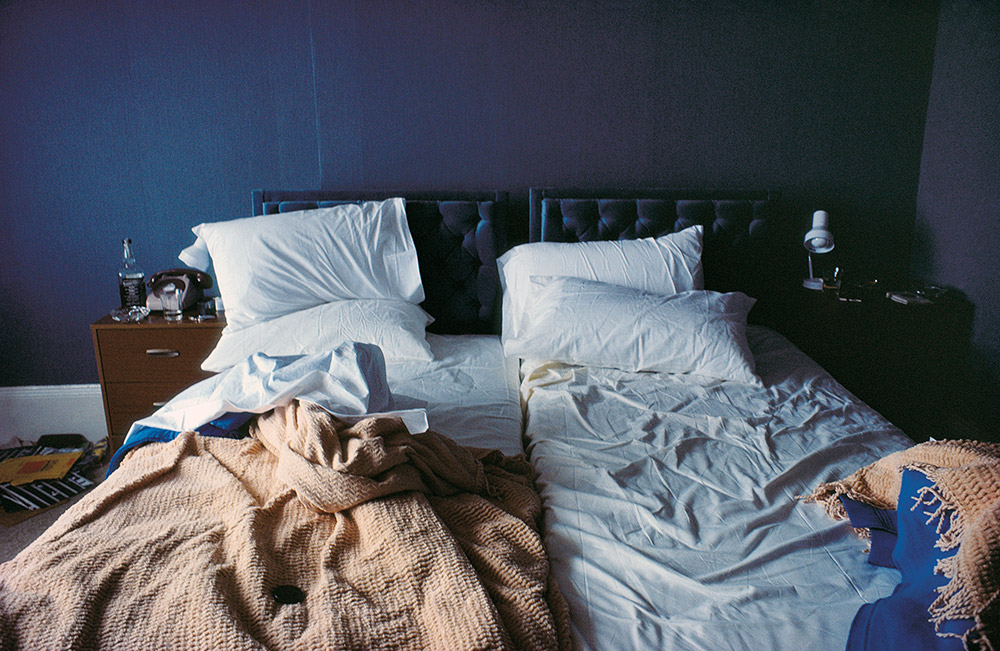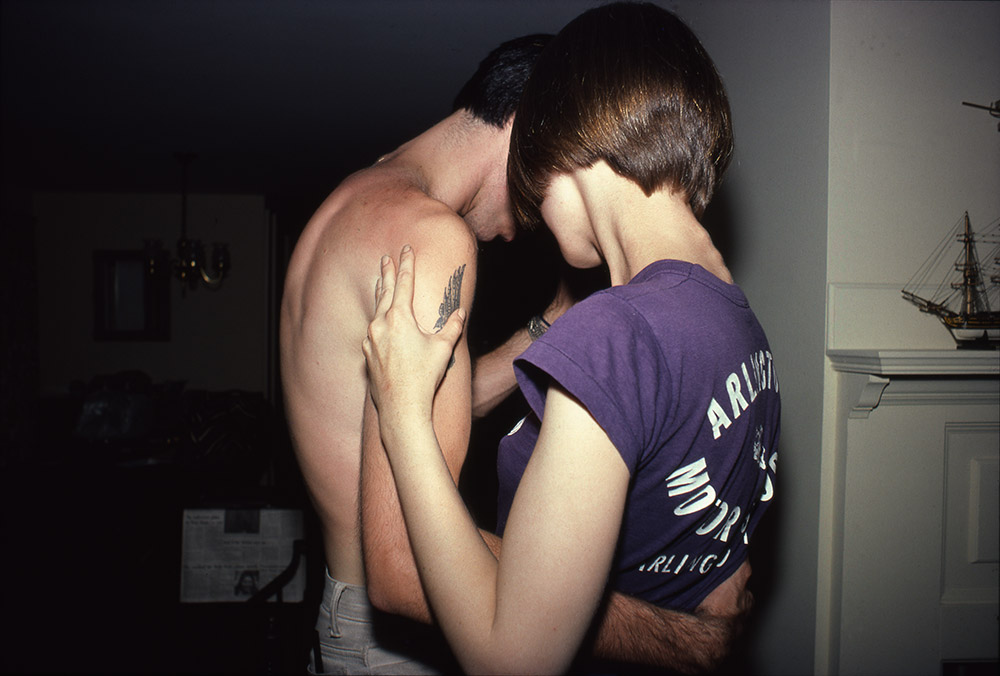by Graeme Kennedy, cross-posted from the Portland Museum of Art blog
Without a doubt, the most interesting aspect of presenting exhibitions is hearing the responses from visitors. For Nan Goldin, the responses have been incredibly nuanced, thoughtful, and surprising. So I reached out to a few folks from around town to have a conversation, hear what they had to say, and get their take. Below are excerpts from my sit-down with MECA student and artist Julien Langevin, and Jenna Crowder, co-founder of art journal The Chart and an artist as well.
Julien Langevin: I obviously knew who Nan Goldin was, being an art student, it’s hard not to. But I wasn’t deeply familiar with her work, or her background, or really anything until I caught wind of this exhibition. My friend had an extra ticket to the lecture that she gave, and I was lucky enough to be brought along. Then, a couple of days later, I went to see the exhibition.
Seeing the slide shows—the first time I came, I sat in on the Scopophilia one for a few minutes—and I don’t have much patience with anything durational, so I was like, “OK, OK. Yeah, this is really cool,” and then left and came back. But I actually came back earlier in the week, this week, and sat for the Ballad of Sexual Dependency, and then sat for Scopophilia again. I realize that the durational aspect was so important. As I sat, I found myself developing relationships with the characters or the people in the photographs that I didn’t expect to, especially the photographs of her lovers, and just how everything was framed. It was really incredible.
Jenna Crowder: I was a little familiar with her work before. I had definitely seen some monographs. I’ve also seen her work in art historical context as well. Immediately after the opening of the show, everyone talking about the slideshows with such a level of enthusiasm that made me really curious.
Graeme Kennedy: Why was the enthusiasm different about this exhibition?
JC: I think it was because a lot of my queer friends were like, “I see myself in the show.” I think that’s a really powerful experience.
JL: I totally agree. Portland has such a queer community. We have art spaces here, but it’s rare to have a larger institution represent that, especially one that is a museum, and that you would traditionally think it would show art history, which is pretty not representative of queer culture.
Also, the way Nan represented her friends who are queer and drag queen friends as such a neutral—[Jenna and I] were talking about this in exhibition. She wasn’t trying to fetishize them or dress them up, but more just observe how they were functioning. I think that that kind of really objective observation is really rare when documenting queer people from that time. A lot of people were homophobic, and transphobic, and still are, but it’s nice that they don’t seem tainted in that vein and that she was very respectful of that.

JC: And the fact that she is documenting herself alongside of it. It is really this symbol of allyship, I think, to say, “This is my family, and these are my people. I’m not separating myself from them. I’m showing the other, but I’m also part of the other,” which I think is a really generous and really warm tactic.
JL: Her documenting her own queer relationships is really cool. I don’t know. I feel like it’s still rare to see that level of queer intimacy with the connotation of this greatly famous artist. I guess that the fact that so many of her subjects or contemporaries—like David Wojnarowicz—died because of AIDS and because of overdoses. It’s just nice to see that that history represented, especially in an institution and in Maine.
JC: [Julien and I] were thinking a lot about that visibility. In Scopophilia, especially, she says this line that…I’m forgetting the exact quote, but something about, “You are being there, and you are witnessing it, and you are making these things visible that were previously invisible.” For this exhibition, that’s a really complicated idea. The slideshows, they become real, especially to someone who’s coming in from outside that community. If this is your community, it’s nothing new necessarily. Thinking about the visibility to this museum’s audience—who that is and what those relationships are—I think, is an interesting question.
I also think that visibility has other effects, too: there are times in my daily life where I want to be invisible maybe—for example, when I think about catcalling or sexual harassment. [Goldin’s] images of domestic violence and abuse make me think of what it means to be seen, and what it means to be objectified, and what it means to glorify or to push back against those things.
She is exploring really complex ideas of visibility that I think are really palpable. I’m still figuring out what she’s doing—I don’t think it’s super cut and dry, which is great.

GK: That visibility is also very present in the use and everyday nature of drug use and abuse.
JL: Yeah, I really wanted to bring that up. I know that she has gotten criticism for fetishizing drug culture or grunge culture, but having that take displayed within the walls of an institution, within a city that is suffering such a huge opioid epidemic right now, with a government that is trying to hush it and ignore it, essentially, is some means to a solution.
The crisis is systematic. It is fed by poverty. It is fed into marginalized communities, and that’s no different in Portland. Recently, with all the developments and stuff in Portland, people want to paint it as this oasis where there are restaurants, the water, beautiful apartments, and history, but then it’s like people are dying, quite literally, on the street.
Centers are being shut down that are trying to aid this problem. There comes a point where you can’t just push it down, and push it down, and push it down. Again, I don’t know what that means. I don’t know what it means that it’s being displayed here, but it’s definitely something that should be considered.
JC: I could see one reading of the exhibition being, “Oh, that was this place and that time. Isn’t it great that we don’t have to deal with that anymore?” I can also see other people really feeling their community is in those images, too, and I wonder how those conversations come together.
GK: What about people who don’t see themselves or lifestyle or history represented in these photographs?

JC: Thinking about visibility of people of color, and this show in particular—I don’t know that it addresses that, and that is a little problematic.
I was remarking that in the first couple of walls of photographs, all of the white people have names, and her roommate, who is of color, is just labeled as her roommate. That felt pretty shocking to me, actually. Whether it was a conscious racist decision, if I can use that phrasing, or if it was just a relational formality, I am not sure. Then I noticed in that first slide show in the club with primarily Asian people, the song “Fever” came on. That really felt bad to me, and I wonder about that decision, too.
There were several instances where I was like, “OK, the show can be really great on one level, really speaking to queer communities, but…” I don’t think that all artists have to speak to all communities all the time, but it does bring questions. What’s the next step that we can take as a community and as an institution? How do we think about representing communities of color, queer communities of color, and other communities that are not so visible. Visibility can create relationships and understandings. Visibility [offers potential for a] shared “This is who we are,” without all the othering that tends to happen, especially here in Maine.
JL: I think it’s even more complicated, too, because Nan, herself, is Jewish, right? It’s like how do we facilitate these conversations, where we’re not erasing her positionality, but we’re also addressing how it can be problematic for other positionalities? I don’t know, but I definitely agree with you that it is a good representation of queer culture, but definitely is not so much of queer people of color.
JC: I think that becomes interesting too, that there is a desire to want all shows to do everything. I think that’s just maybe indicative of the fact that we [tend to] see work from the same type of artist most of the time. With more shows from more perspectives that speak to lots of different people, that pressure might be a little lessened once there is also a diversity in representation that feels good.
JL: That’s the importance of having inclusive shows, and if they’re not necessarily reaching all marginalized audiences, having conversations about why that’s problematic, and how that excludes communities that aren’t seeing themselves in the work and stuff like that.
JC: [Seeing yourself in works of art at a museum] feels less isolating, right? There is power in that. It means something to be part of the conversation.
Nan Goldin is on view at the Portland Museum of Art from October 6, 2017 to December 31, 2017. This conversation was originally featured on the Portland Museum of Art blog: https://www.portlandmuseum.org/blog/community-takes-jenna-crowder-and-julien-langevin-nan-goldin.
Portland Museum of Art
7 Congress Square Portland, Maine 04101 | 207.775.6148
info@portlandmuseum.org
Open Wednesday, Saturday, and Sunday: 10am–6pm, Thursday and Friday: 10am–8pm. Adults: $15, seniors: $13, students with valid i.d.: $10, children 14 and under are free. The PMA is free on Friday evenings from 4pm to 8pm and free for members.

Graeme Kennedy is Director of Marketing and Public Relations at the Portland Museum of Art in Portland, Maine. Graeme is a Maine native who, after ten years living in New York and the west coast, decided to come back and set up shop in Portland. In addition to the PMA, he’s held positions at GQ, Rogues Gallery, and Might & Main. He lives in Yarmouth, where he spends most of his free time with his daughters.

